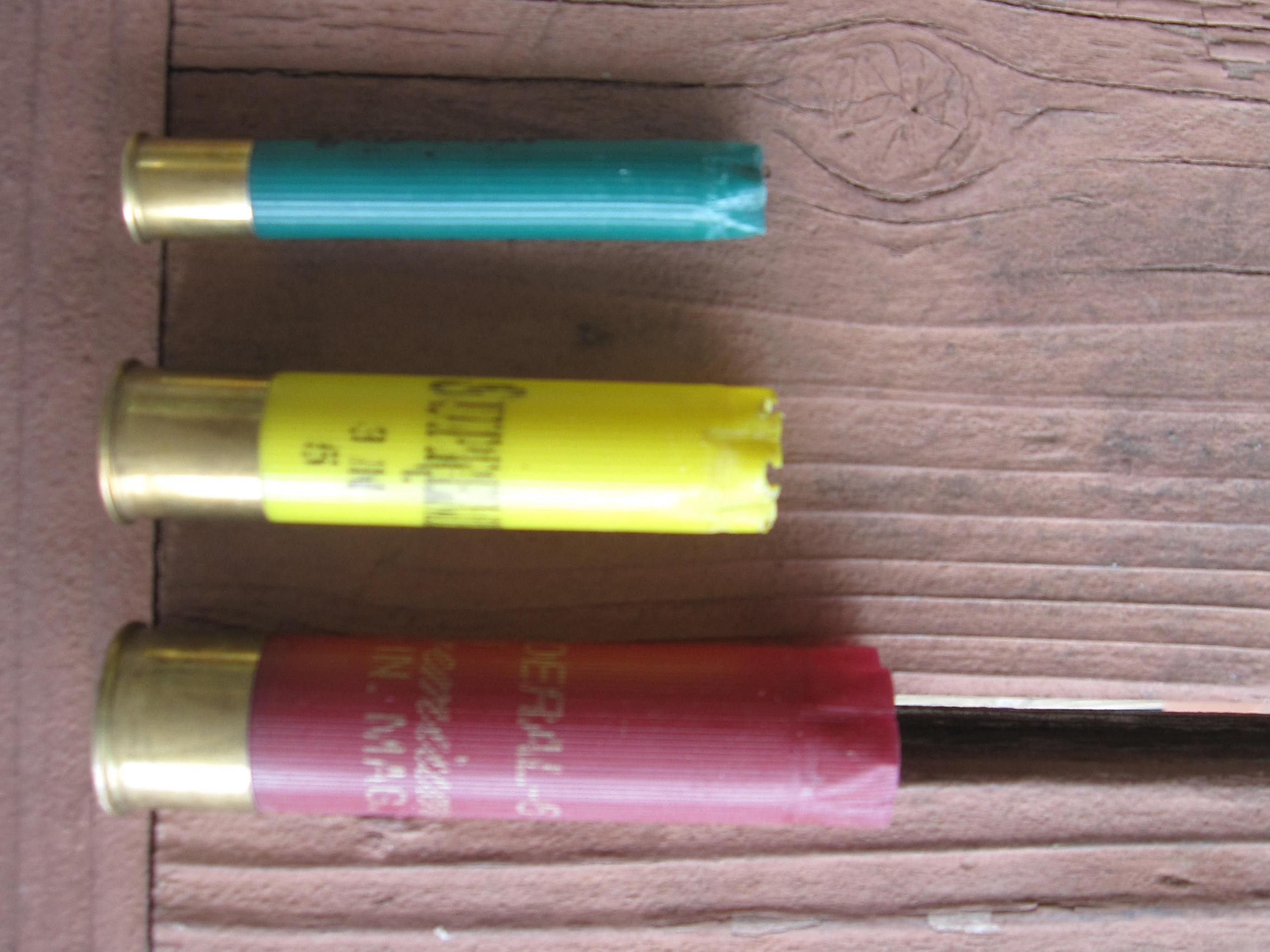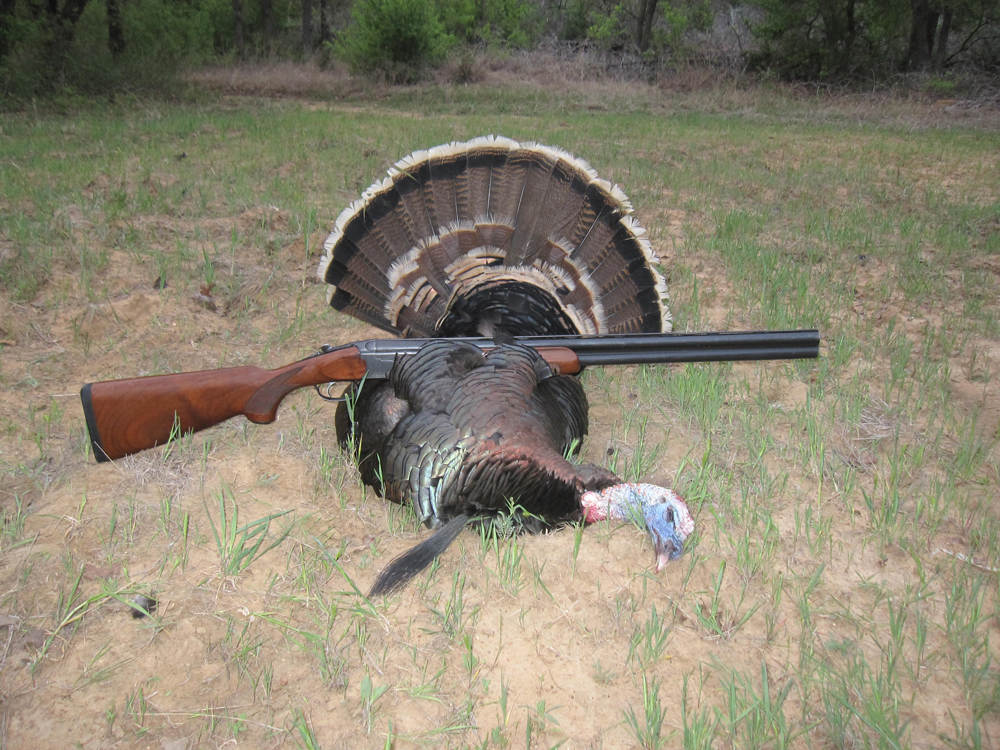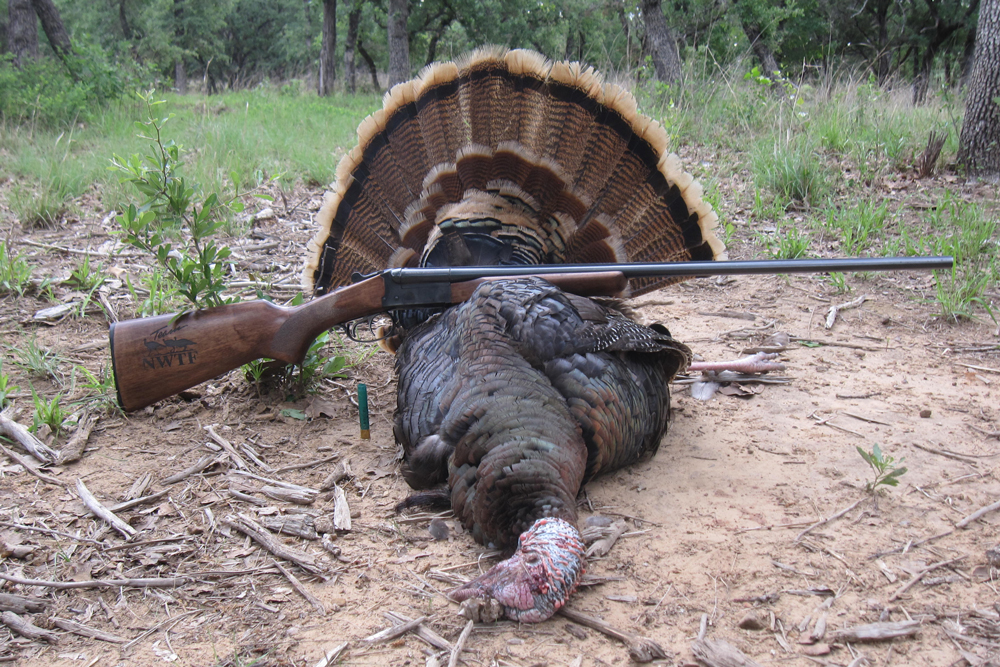I left camp early and was as quiet as possible traversing the creek bottom. I settled into the base of a fallen tree just off the edge of the field, surrounded by limbs and low brush, and began to unpack my calls and get organized in the darkness. Suddenly a tom gobbled behind me, announcing his presence to the world. I had slipped right past him without spooking him—a first.
Instead of having to entice a gobbler to cross a large field, I had the opportunity to ambush him at the near edge . . . if I could call him in. I shifted around to take advantage of this unexpected opportunity. The tom flew down, responded enthusiastically to my calls, and walked straight up the ranch road to the edge of the field. I saw him early through the branches and made ready. He walked slowly into the field, looking for the “hen,” and when he came even with me, I touched off my 3½-inch-chambered Beretta Onyx. The tom dropped just 16 yards away.
It was 7:20 a.m. on opening morning. As I admired him and soaked in the beauty of Texas in the spring, I couldn’t help but feel wistful, thinking that my turkey hunting was probably over for the year. Little did I know that my magical season was just beginning.
I love spring turkey hunting. It is second only to bow season in my personal ranking of hunting, and not far behind. I gained an appreciation for the challenges of turkey hunting during my early years, taking my first spring turkey in my fifth season. I love the challenge it presents and the satisfaction of meeting that challenge. As I applied lessons learned and gained some level of skill, my successes increased, and eventually I was asked by friends to act as an informal guide.
A decade ago I began exclusively hunting on a small tract of land with a couple close friends. Though four turkeys are allowed in most Texas counties, I limited myself to one turkey a year due to the size of the place. I quit method hunting and used my Onyx exclusively—if you take only one shot per season, you need to bring all you have.
Then we had a serious run of good luck. Our ranch received two consecutive years of above-average rainfall. As a result, game populations exploded, including turkey. We allocated ourselves two spring turkey and were also offered the opportunity to hunt a nearby ranch; my friend Ken took two nice toms there opening day. To top it off, we were asked to introduce a good friend to turkey hunting at his ranch the following weekend.
Having already taken a nice gobbler with my Onyx, I decided to try something I hadn’t done in years—take a tom with my 20-gauge Browning Citori. The Citori is my favorite dove and sporting clays shotgun. I use a Briley extra-full choke that extends past the barrel with my regular full choke that does not. It looks funny, but its purpose is to kill a turkey, not look good.
The second weekend turned out to be just as spectacular. I was able to call in two mature toms the first morning, and John made a nice shot in taking his first spring turkey. A couple setups later Ken and I combined to call in multiple jakes, with Ken taking one.
The second morning I set off alone to see if I could still take a turkey with a 20 gauge. I set a hen decoy in a likely area and settled in 15 yards away. I called in a group of five—two mature toms and three jakes. One tom held back well out of range as the remaining four approached the decoy. I could have taken the other tom but would have almost certainly killed the jake closest to him as well, and I didn’t want that. Then the largest jake moved slightly to one side, clear of the others. I took it as a sign and did not hesitate. He dropped at the blast 26 yards away.
As I admired my turkey, I realized I was on a roll . . . and that rolls need to be ridden, hard. It was still early in the season, turkeys were plentiful, I had access to three ranches that were only lightly hunted, and I had already called a dozen turkeys within killing range. Right then I made a deal with myself. I would hunt one more turkey, but with my .410.

Three birds, three shells. The author took a turkey with a 12, 20, and .410 shotgun, all in one stellar season.
Years ago I won a Stoeger side-by-side .410 at the local National Wild Turkey Federation dinner. It has two triggers and is choked full and full. It is “challenging” to shoot in the dove fields or on the sporting clays range, as my battered ego can attest, but has both broken clays and taken doves when I did my part. Now I had to find out if it could ethically take a turkey.
I chose the 3-inch Remington shell with 11/16 oz. of #6s. Next I checked with my gun guru, Mike Massey. He is the guy who has answered my questions, offered advice, and made gentle suggestions on all things guns, ammunition, and shooting for around 25 years. Mike said that it was imperative to pattern the shotgun carefully to know exactly where each barrel shot and determine the ethical range, so I patterned both barrels at 22 yards.
Mike was right, as usual. The left barrel shot left of point of aim with a ragged and variable pattern. The right barrel shot exactly point of aim with a dense, regular pattern. I decided that 25 yards was my maximum range with the right barrel and added a laser rangefinder to my pack.
Now the trick was to call a turkey within .410 range. I set up at a favorite spot of mine, a relatively open area dotted with trees and surrounded by thick brush—an excellent strutting and breeding area. I was right about turkeys wanting to be there, but I was wrong in my setup. I did get to watch turkeys play house for an hour, albeit at a distance—six hens, two toms, and a jake.
After the hens went to nest and the toms wandered off looking for other mates, I searched for the perfect spot. I found a small ring of trees with new growth, which provided a natural ground blind. I would have shots in three directions and multiple trees I could use as precise distance references. Thank you, rangefinder.
The next Saturday found me at that spot well before daylight. Everything was perfect except the howling wind. Toms rarely gobble in high wind, hens both move less and yelp less, and it would be harder for a turkey to hear my calling. I decided to just grind it out and try to reel in a wandering tom, only calling during lulls in the wind. I tried to stay both still and alert, as a tom would probably sneak in as opposed to announcing his presence with a gobble.

An unforgettable turkey season in the heart of Texas.
Then the wind died for five minutes and I was able to complete multiple sequences of calls. After my final sequence I put down my box call and shifted my shotgun into position. Almost immediately four toms, heads flushed red with excitement, appeared directly in front of me. The turkeys jostled each other as they came into the clearing at a fast walk. They stopped for a moment as a group, looking for the hen. When they did not see one they began to mill around, slowly closing the distance.
One tom was clearly an older bird with a long, full beard; the others were younger. True to form, the older bird held back as the other three began to fan out in slow motion. A young tom with a short, thick beard stepped behind a tree 19 yards away, allowing me to shoulder the .410. He came back into sight in front of the tree and stopped as I took aim. He was so close and the recoil of the .410 was so mild that I believe I saw the pellets’ impact. He dropped immediately as I lumbered to my feet and hurried to him. There was no need to hurry; he fell 17 yards from the muzzle.
The .410 can now rejoin its brethren in the shotgun rack with new bragging rights, and has even earned itself a name—Little Gun. I was successful in taking my trifecta of turkeys, something I doubt I will ever accomplish, and probably never attempt, again. But I did it once, and that is enough for me.

